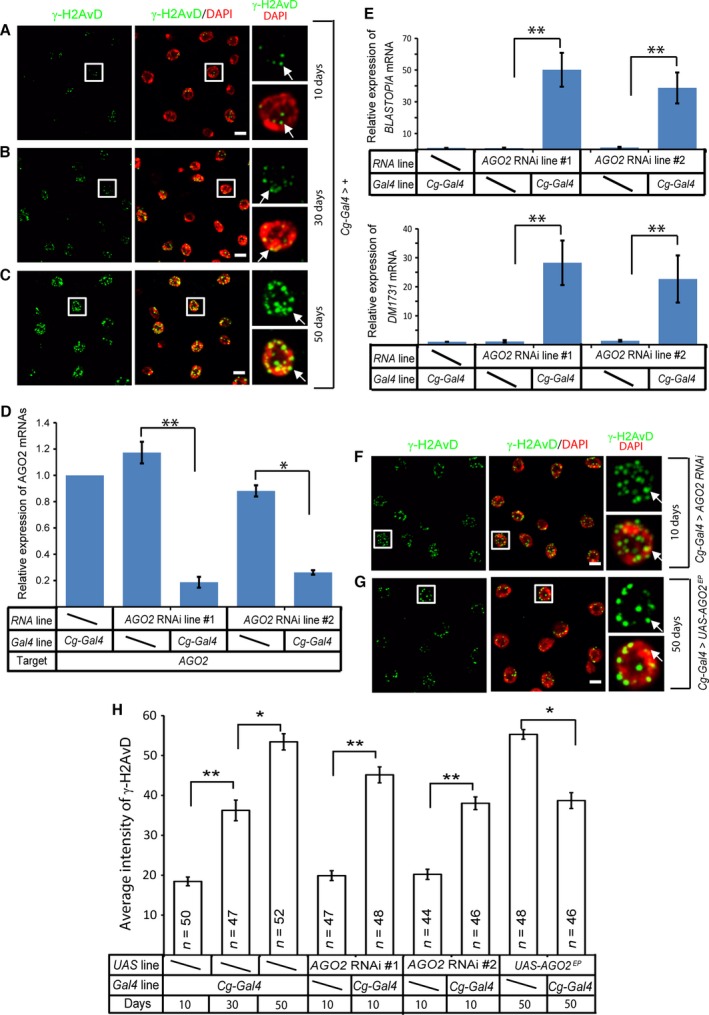Figure 2.

Retrotransposon de‐repression leads to DNA damage in old fat bodies. (A–C) Representative immunostaining images of γ‐H2AvD (green) and DNA (DAPI, red) labeling in fat bodies (from the A4 region). 10‐day‐old young control fat body cells (A, Cg‐gal4/+;tub‐gal80 ts /+) had a few faint nuclear γ‐H2AvD signals, which was gradually increased by 30 (B) and 50 days (C). Nuclei outlined by white squares are enlarged to the right. White arrows indicate γ‐H2AvD staining foci. Scale bars, 20 μm. (D) Two independent fly lines carrying fat body specific RNAi (Bloomington Stock Center, #34799 and #55672) driven by Cg‐gal4;tub‐gal80 ts exhibited significant reduction of AGO2 in fat body. The fold change of AGO2 expression was determined relative to the Gal4 control flies (Cg‐gal4/+;tub‐gal80 ts /+), which was set to 1. Error bars, SEM based on three independent experiments. Student's t‐tests: *P < 0.05, **P < 0.01. (E) Depletion of AGO2 in the fat body by the two different AGO2 RNAi allele (Cg‐ gal4/AGO2 RNAi#1;tub‐gal80 ts /+ and Cg‐gal4/AGO2 RNAi#2;tub‐gal80 ts /+) significantly increased the expression of two retrotransposons (BLASTOPIA and DM1731) that were found to undergo age‐associated up‐regulation in fat body. The fold expression change was determined relative to the Gal4 control flies (Cg‐ gal4/+;tub‐gal80 ts /+), which was set to 1. Error bars, SEM based on three independent experiments. Student's t‐tests: *P < 0.05, **P < 0.01. (F–G) Depletion of AGO2 (Cg‐gal4/AGO2 RNAi#1;tub‐gal80 ts /+) by RNAi in fat bodies increased γ‐H2AvD signal in 10‐day‐old young fat bodies (F), whereas the expression of AGO2 (Cg‐gal4/+;tub‐gal80ts/ UAS‐AGO2 EP) in fat bodies reduced γ‐H2AvD signal in 50‐day old young fat bodies (G). Nuclei outlined by white squares are enlarged to the right. White arrows indicate γ‐H2AvD staining foci. Scale bars, 20 μm. (H) Quantification for γ‐H2AvD intensities in fat body cells from 10‐, 30‐, or 50‐day old Gal4 control flies (Cg‐gal4/+;tub‐gal80 ts /+), UAS control flies (for AGO2 RNAi#1, AGO2 RNAi#2, and AGO2 EP line), 10‐day‐old flies with AGO2 depleted in fat body (Cg‐gal4/AGO2 RNAi#1;tub‐gal80 ts /+ and Cg‐gal4/AGO2 RNAi#2;tub‐ gal80 ts /+), and 50‐day old flies with extra AGO2 expression in fat body (Cg‐ gal4/+;tub‐gal80 ts /UAS‐AGO2 EP). The γ‐H2AvD signal was determined by measuring the total nuclear immunofluorescence signal from the images captured using the same microscopy settings (see the detailed description in the experimental procedures). Nuclei from the A4 region (see Fig. 1A) were measured to allow the comparison among different fat bodies. Error bars, SEM. Student's t‐test: *P < 0.05, **P < 0.01. The numbers (n) of fat body cells analyzed shown were from three independent experiments.
